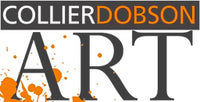The practice of abstraction in art refers to the use of 'gestures' to suggest the subject rather than creating accurate depictions of imagery. It can apply to different components of a piece, including colour, shape, line and composition.
Exploration of form and colour is at the heart of any abstract piece, making use of ambiguous elements to hint at reality or a particular meaning.
The origins of abstract art began very early in the 1900s, during the Modern Art movement, when rapid technological advancements in the West meant that artists needed to find new ways to represent the world around them and its hastily changing ideas and possibilities.
Early in the 20th Century the movement Fauvism saw a collection of modern artists, including Andre Derain and Henri Matisse (led by Gustave Moreau, a Symbolist painter and professor at Ecole des Beaux-Arts), favouring obvious brushstrokes and strong, unorthodox colour schemes to create their paintings.
Perhaps the most revered of the Fauve's paintings is Le Bonheur de Vivre by Matisse, 1906, which at the time shocked people, who were more used to seeing faithful representations of scenes rather than this bold and colourful imaginary mingling of pink and red landscapes, multi-coloured trees, and Japanese woodcut inspired figures.
In later life, Matisse would move further into the world of abstraction with pieces like Icarus, 1947, which saw him pioneer the paper cut out technique after he began to suffer from ill health and found conventional methods inaccessible to him. This technique involved painting single pure colours onto paper, then cutting shapes and layering them to form a 'collage' effect.
Icarus features a simplistic abstract figure in flat black punctuated with a bright red 'heart', set against a bold blue background dotted with bright yellow bursts of colour. This imagined visual representation colourfully depicts the character Icarus from Greek mythology falling from the sky, wings ablaze, after being steered by his passionate heart and flying too close to the sun.
Where Fauvism deliberately skewed colour and form using imaginary elements, Cubism, which followed soon after, conspicuously and exaggeratedly altered the real-life subjects which it depicted. Instigated by Pablo Picasso, this avant garde art movement presented real entities by breaking them apart and reassembling them in abstract form.
Famously, Picasso would create portraits of people with unusually shaped bodies and distorted features, making use of atypical colours for the subject and kaleidoscopic effects.
In 1912, he produced the abstract cardboard sculpture Guitar using a technique known as assemblage. This played with the realms of reality and perception in a 3-dimensional format to 'suggest' the form of the guitar – relying on the flexibility of the viewers' ability to perceive a visual interpretation from context.
For example, the sound hole on an actual guitar is a recess into the instrument, the sculpture represents it by using a tube protruding outwards from the piece, yet the the observer can unravel the abstraction and interpret the image due to the grouping of the other irregularly formed parts.
Abstract art continued to develop throughout the Modern Art movement, via Futurism and Abstract Expressionism. From the 1980s High Modernism saw abstraction in art persist onwards through Minimalism, Symbolism and right through to current day contemporary art.
In present times there are a myriad of examples of abstract art, freeing the artist (and observer) as it does from the bounds of reality, providing a versatility and singular aesthetic.
Take, for example, the use of pure bold colours and simplistic and distorted figures in original painting Amanti X by contemporary Italian painter Silvio Vigliaturo, which is reminiscent of Matisse's rudimentary Fauvist figures or paper-cut-out pieces. Silvio's vibrant glass sculptures, like Il Druido, also have a distinctly Cubist style to their composition.
In a similar vein to Dutch painter and art theoretician Piet Mondrian (who once said “Art is higher than reality and has no direct relation to reality. To approach the spiritual in art, one will make as little use as possible of reality, because reality is opposed to the spiritual”), Ilse Michielsen paints abstract pieces
which are rooted in nature – even using natural elements like sand, glass and animal skin in her work.
The original painting Later, in particular, makes similar fearless use of geometric blocks of blue and red, broken into sections and highlighted with gold and yellow.
The daring and expressive sweeps of oil colour in Tabitha Salmon limited edition print Millenium Wheel IV bear resemblance to the partial abstraction techniques employed by German visual artist Gerhard Richter. Though largely containing no distinguishable elements, Tabitha's composition is masterful in its
proposition of the motion and form of the London Eye and South Bank.
Josie Appleby, too, employs similar techniques to Gerhard Richter, pouring and swiping paint onto her canvas as well as painting finer detail highlights which allude to the subject matter. One of her latest original paintings Before the Race and limited edition prints Yearlings and Flying Blue, each relies heavily on a dark and brooding abstract background of layered oil paint, with her equine subjects subtly described simply by a light use of dark golden highlights which successfully suggest the contours of the subject.
Suffolk artist Chris Ross Williamson's wonderfully quirky limited edition print Huge Pollocks pays a tongue-in-cheek homage to abstract art featuring a piece of 'art within art' – a man and his dog admiring the Abstract Expressionist painting Autumn Rhythm by Jackson Pollock!









